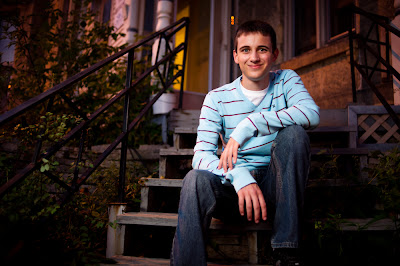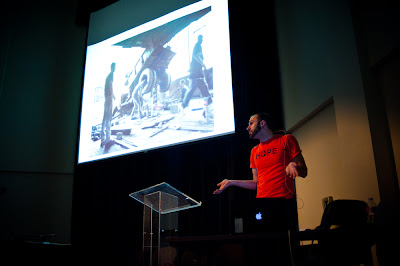Hello, my name is Matt Kirk, and I read a lot of gear reviews.
And I am disappointed with almost all of them.
When I look into a review, I want some sort of insight into how this sort of gear will be more effective; but most lens reviews care a lot more about qualitative measurement of sharpness, bokeh, and color fringes than I do. I do care about this (to a degree) but I want to know more about how this lens works in making images than how it performs technically. These kinds of technical reviews breed unhealthy attitudes towards lenses; it is foolish that people choose to use a lens because someone says that it is “good.” I hear a lot of this type of talk in photo chat rooms; hence I do not go near them anymore.
Therefore, I am going to write a lens review about what I think a lens review should be concerned with. This is a review for every prime lens on the market with a 35mm focal length. (i.e. If you shoot with a cropped camera like 1.5x or 1.6x, this is the 24mm.)
Sorry, this may be long...
Why the 35 works for me:
My photography tends to take on the form of story telling through environmental and candid portraiture; therefore, context is very important. Even when I am not photographing portraits, the context and story is still very important to me. Conversely, if I were a wildlife photographer, this lens may not work as well because I would need to focus on things farther away. For the relative distances between my camera and my subjects, I have found this lens works well, not just because of the field of view, but also how that field of view looks. It has a hint of both a standard and a wide angle. (Of course it does Matt, it is right in the middle of a 50mm and 24mm.) It is not as narrow as a 50mm so I can be closer to my subject for an environmental portrait, and yet is not as wide as a 24mm so it doesn’t have the extreme near-to-far distortion of a 24mm...and people don't look stretched out when they are near the frame. The 35mm can feel like a wide angle with a step backwards, and like a detail lens with a step forwards.


But this also is determined by how you see the world. I have always liked wide angles; without fail, I pick up a lens and zoom it to the widest that it can go. When I switched to a full frame camera, I thought I was in heaven with my 17-35mm, but I started noticing that there was a lot of disorder and confusion in my images. There was too much to look at and make sense of. Using a lens that is not as wide as I usually shoot, I was forced to think about how to fit things into the frame that I wanted. I started to jockey my position with the other elements in the frame in order to make it all fit and work.
Now I can go back to a wider focal length and see that I do not really need to shoot at the widest all the time. But when I do need to shoot at wider, I find that I have a lot more order to my images, and I am more aware of how the distortion is playing on my subjects.
(shot at 22mm, but with lessons learned from the 35)
Yes, it’s a prime:
A definite strength of this lens is that it forces me to think about my photography. Since it is a prime lens, I have to work a lot more at my framing. I can no longer stand still and compose any photograph in front of me by zooming, I need to be physically active. This is a good thing. Limitation breeds work, and work breeds creativity. I have learned more about composition by being forced into this focal length than I ever did with years of using zooms. Sometimes, zooms give me too many options, so it is easy to find a focal length that can work and create a good enough image. But what about creating great images? That requires work.

Some people call this concept of jockeying around for the best position “zooming with your feet.” I think this is a misnomer. The act of zooming changes your focal length, and therefore changes your lens properties. Yes I need to walk closer to my subject to fill the frame with their face, but this will never look like I zoomed to 105mm. If you want the look of a 105, you need a 105mm lens. Therefore “zooming with my feet” is not what I am doing. I am actually changing my subject to camera distance and therefore changing how this lens sees the world. If you stand in one place and zoom you lens, you are not seeing the world differently, just a smaller portion of the world. (That is sometimes a very powerful tool by the way.)

Many times I am a little scared to take only a prime out into the field for an assignment. I am always afraid of “missing the shot” because I do not have the "right lens." But if I were to carry every lens I may need, just in case, I would actually stifle myself. I have done this, I have become really frustrated with to many options, so I resorted to putting everything away but the simplest lens combination I had. Then I started to feel free.

“But Matt,” you are saying, “I can do all this with my 50mm too!” Yes you can, and please do. I have, and use, other prime lenses, and they all have this magic quality to them. I also have zooms, and I do use them. After using primes, it has changed how I use zooms too. I no longer carry all of the lenses I have access to out into the field; the idea here is to limit yourself, not cover all your bases. Know what you will use 85% of the time, and only take that. This was not intended to be “prime vs zoom” comparison. It is very difficult to compare apples and oranges. When you crave an apple, eat one. When I need the convenience of a zoom, I use that.
Finally:
I am not saying that the 35mm is my “shoot with one lens for the rest of my life” type of solution. I think that is a silly question, but it is a top choices to the age old question of which tool to use when you are not sure which problem to solve. Because of how it fits my style of photography and how it allows me to capture what I am attracted to; this lens is a great teacher, it stretches me, forces me to be creative with little, and allows me to enjoy what I am photographing.
An added benefit (and sometimes its biggest strength) is how light and small this lens is. After days of carrying around many pounds of glass, it is a treat to go this light. It is also gratifying to create compelling images with so little...it is like I am making the image and not the camera. Imagine that!






























































